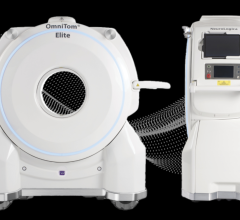
CM = contrast media; CO2 = carbon dioxide; Gd = gadolinium; IVUS = intravascular ultrasound. Image courtesy of the Journal of Vascular and Interventional Radiology
June 23, 2022 — Supply chain disruptions have created critical shortages of Omnipaque (iohexol) and Visipaque (iodixanol), iodinated contrast media agents used in imaging studies for the diagnosis and treatment of disease. GE Healthcare, the manufacturer, had to shut its plant in Shanghai, China, due to local COVID policies, disrupting 80% of their production. Writing in the Society of Interventional Radiology’s flagship publication, the Journal of Vascular and Interventional Radiology (JVIR), published by Elsevier, investigators provide clinicians with guidance on alternative imaging methods for interventional radiology procedures and strategies to maintain the short supply for emergencies.
“As interventionalists, adaptation is at the core of our specialty, and this situation has proved no different,” said lead author Nikki A. Keefe, MD, Department of Radiology, University of North Carolina at Chapel Hill, NC, USA, and her co-authors. “We have developed an initial approach to case prioritization, and we also looked at short-term strategies for the management of existing supply to optimize utility and minimize waste.”
In response to this shortage, the American College of Radiology (ACR) Committee on Drugs and Contrast Policy has published a guidelines statement. Using these guidelines as a foundation, Dr. Keefe and her co-authors offer a set of practical solutions to deal with the current situation.
The authors recommend creating a priority matrix covering the following categories: procedures that require iodinated contrast media versus procedures that can be deferred; those that can be performed with alternative imaging modalities such as intravascular ultrasound; and those that can be performed with an alternative contrast media. They emphasize the importance of creating harmonized leadership to oversee contrast media use across all departments at an institutional level. This would include both diagnostic and interventional teams, including non-radiological divisions that also utilize iodinated contrast.
While case prioritization and the use of alternative contrast media may stretch the supply, many interventional radiology procedures will continue to require these agents. As part of the centralization of contrast media management, Dr. Keefe and co-authors recommend that a central pharmacy and inventory system be used to distribute the agents. At the point of care, multiuse valved equipment and the dilution of contrast media with saline may be appropriate and can extend supply and minimize waste.
Alternate contrast agents may be appropriate for some patients. With maximum dose recommendations, gadolinium (Gd) can be used in the vascular system even for patients with renal insufficiency. Carbon dioxide has been used as a safer alternative to iodinated contrast media in patients with renal dysfunction or allergy, although there are some associated risks. To prevent ischemia, dosages should be timed one to two minutes apart. While alternate contrast agents have limitations in defining the anatomy of large diameter vessels such as the aorta, digital stacking of images may improve visualization.
For nonvascular gastrointestinal and genitourinary applications, alternatives are available. Gastrografin (diatrizoate meglumine, Bracco Diagnostic Inc.) for oral or rectal administration is a safe alternative for gastrointestinal access and catheter exchange procedures. Cystografin (diatrizoate meglumine, Bracco Diagnostic Inc.) by injection is a viable alternative for genitourinary access and procedures including nephrostomy and nephroureteral stent placement/exchanges. Intravascular ultrasound has an established role in vascular procedures, and it can obviate the use of contrast media and decrease radiation exposure and procedural times. With appropriate training, clinicians can apply intravascular ultrasound for procedures such as inferior vena cava filter placement and transvenous biopsy.
GE Healthcare recently announced that it has been able to reopen its Shanghai facility, but distribution and other supply chain issues may linger. “That being said,” Dr. Keefe and co-authors cautioned, “with China’s zero-COVID policy, a shutdown may unfortunately happen again, and it would be prudent to have a plan in place should shortages recur.” They suggest that some of the changes in practice and procedures that are being implemented as a result of this shortage may prove to be beneficial and permanent, adding, “they may serve patients in the long term by minimizing both contrast media load and radiation exposure.”
“JVIR is built on methodical peer review of research and evidence-based medicine, but to serve our readership in this time of international emergency, rapid publication of practical instructional material was warranted,” stated Daniel Sze, MD, PhD, Editor-in-Chief of JVIR.
For more information: www.elsevier.com
Related Content of MRI Gadolinium Concerns
AJR Publishes Best Practices for Iodinated Contrast Media Shortage
Voluntary Dismissal of Chuck Norris Gadolinium Case Involving Bracco
VIDEO: How Serious is MRI Gadolinium Retention in the Brain and Body? An interview with Max Wintermark, M.D.
VIDEO “Big Concerns Remain for MRI Gadolinium Contrast Safety at RSNA 2017,” An interview with Emanuel Kanal, M.D.
Radiology Has Failed to Properly Assess or Track MRI Gadolinium Contrast Safety
Recent Developments in Contrast Media
FDA Committee Votes to Expand Warning Labels on Gadolinium-Based Contrast Agents
European Medicines Agency Issues Update on Gadolinium Contrast Agents


 July 30, 2024
July 30, 2024 








